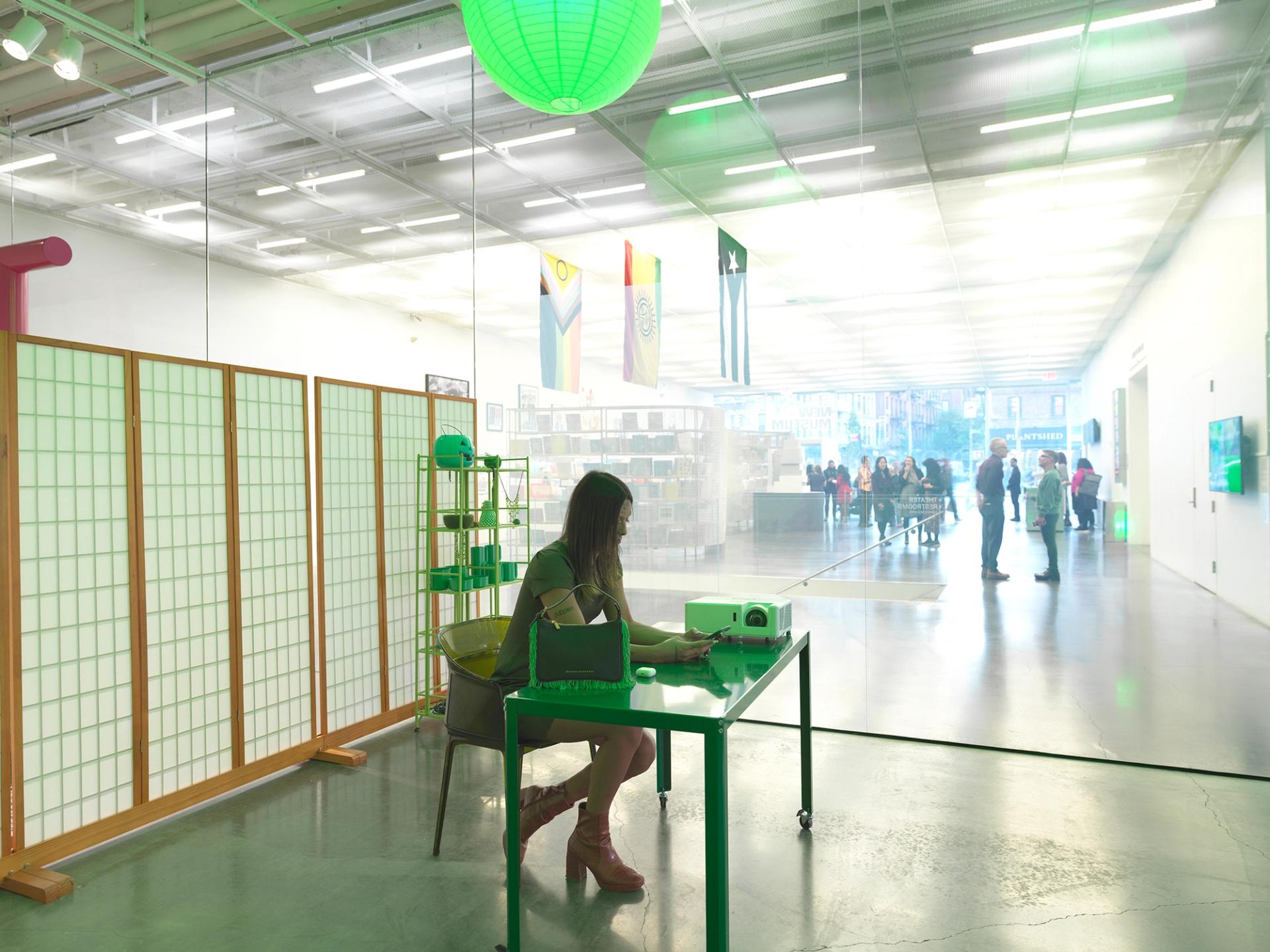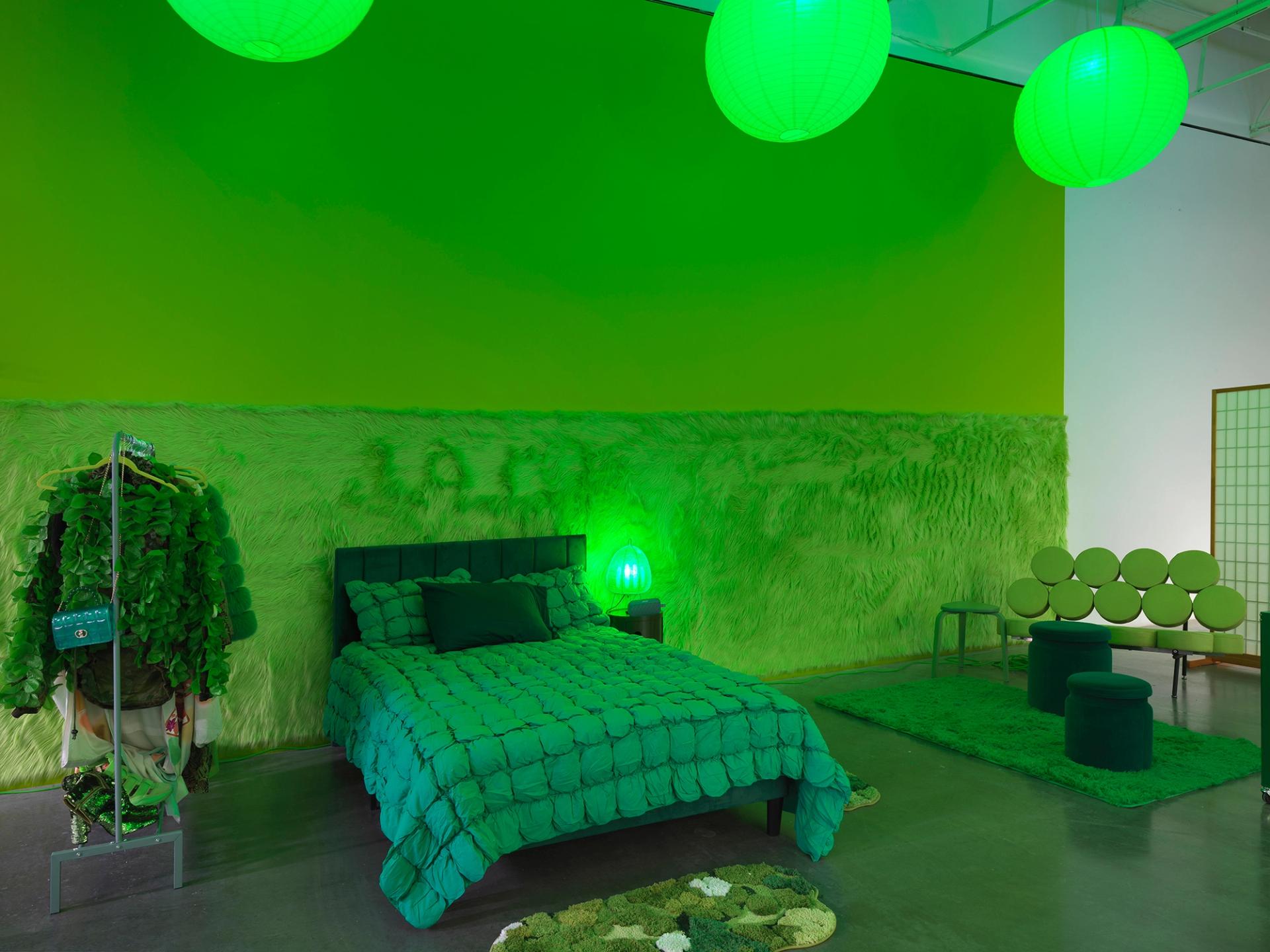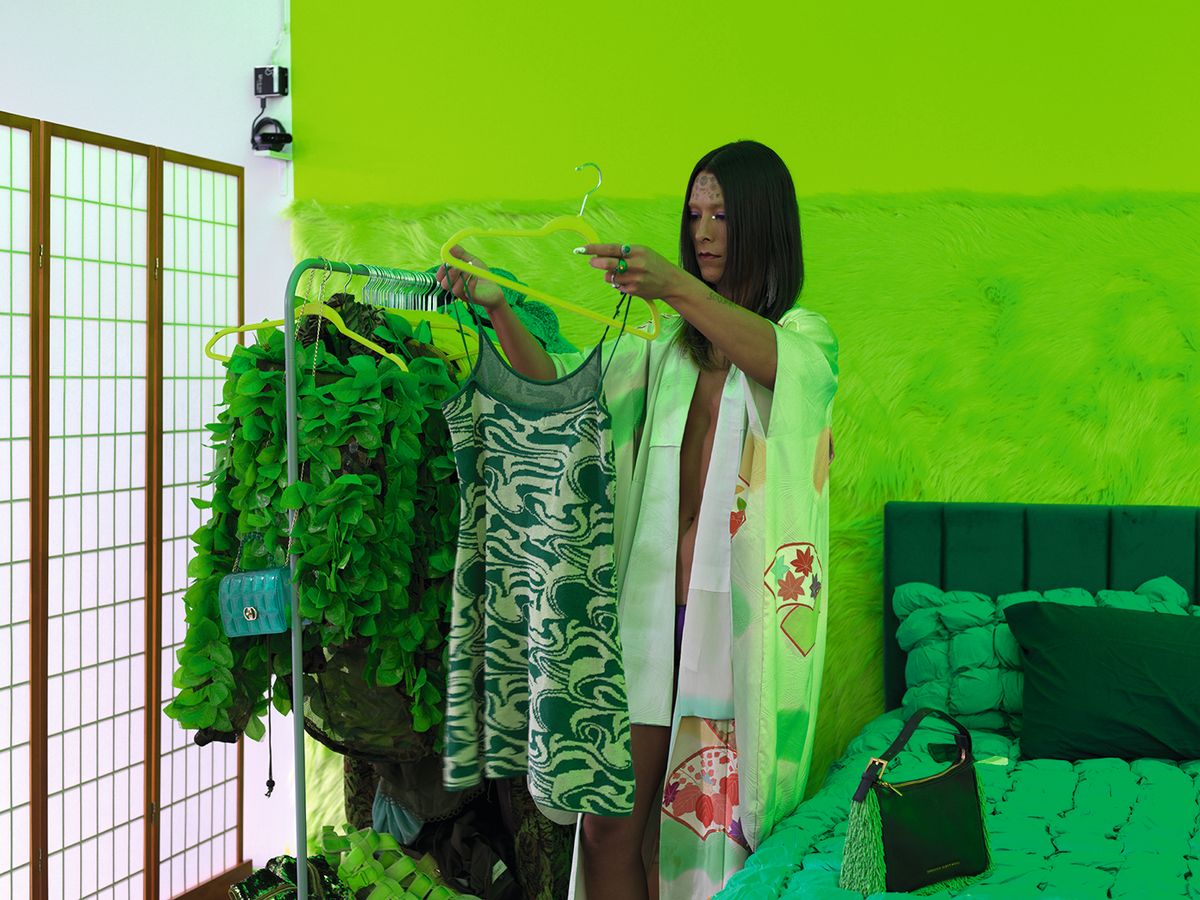Puppies Puppies (Jade Guanaro Kuriki-Olivo) is at home in New York’s New Museum. Literally. Until 14 January, the trans performance and installation artist is living and working behind a protective wall of glass in the museum’s lobby. You are invited to watch. Whether in residence or in her apartment after museum hours, a webcam will spy on the artist, even when she sleeps. That is because art never rests—and, in this case, the artist is the art.
Nothing New is Kuriki-Olivo’s first solo exhibition in New York. Think of it as an eyes-only studio visit from which you are otherwise locked out. Blocking your way is a pink torii gate, the traditional entrance to Shinto temples in Japan, where the artist’s mother was born. Rice-paper screens separate a serene rock garden and a hothouse for hemp plants from a replica of Kuriki-Olivo’s small, Lower East Side apartment. It is the monochromatic centrepiece of an installation that takes the artist’s body, life and activism within the trans community as its subject.

Exhibition view of Puppies Puppies (Jade Guanaro Kuriki-Olivo): Nothing New, 2023, at the New Museum, New York
Courtesy of New Museum. Photo: Dario Lasagni
But the space is also a shrine to the colour green. Everything in it is a shade of green: bed covers, clothing, table, marshmallow couch, globe chandeliers, throw rugs, an étagère and the entire back wall of the set. The colour narrative continues in the lobby at what used to be a coffee bar; now, it’s a survivalist’s pantry stocked with tinned food, soft drinks and snacks—all chosen for their green packaging. So fun! So metaphoric, like every part of this show.
For example, Kuriki-Olivo did not choose to call herself Jade on a whim. The name, she says, is popular in Puerto Rico, where her recently deceased father was born. But what is green if not a blend of two colours: yellow and blue? Apt for a biracial, bipolar, trans artist straddling the art world and an unsympathetic or indifferent world outside her community.
All studio visits are a minefield. No exception here. Several threats to complacency await, and contradictory feelings abound. Is this to be a cage match or a love fest? Is the visitor an engaged viewer or an invasive force? Is the artist selling something or defending her territory?
All about exposure
Prior to this encounter, the most bizarre studio visit of my life—and the most memorable—was with none other than Puppies Puppies, who slept through it. This was in 2017, pre-transition, when the artist was married and living in Los Angeles. After walking through tautological displays of blue, yellow and green household objects, I was left alone with the artist in a bedroom so dark that it took time to make out the prone figure dressed in a Voldemort mask and costume. I was flummoxed. I waited—for the prosthetic hands to move, for the eyes to open, for a sound. I felt like a trespasser. I could have wreaked havoc. Instead, the artist messed with my mind without moving a muscle. I departed, unsettled.
This was taken from a series of “sleeping performances” where the artist only appeared in public as a cartoon character, costumed to hide any identifying physical attributes such as age, gender, or ethnicity. (Puppies Puppies began as a Facebook handle). When she began taking hormones, Kuriki-Olivo threw off the mask and went for total exposure. In a subsequent series of performances that took place in galleries and museums over the course of a year, she stood for hours, naked. For the first, at Balice Hertling in Paris, the gallery was equipped with a fog machine, making viewers work to discern the physical changes to her body over the run of an exhibition.

Exhibition view of Puppies Puppies (Jade Guanaro Kuriki-Olivo): Nothing New, 2023, at the New Museum, New York
Courtesy of New Museum. Photo: Dario Lasagni
At the New Museum, exposure is key. The artist lolls on her bed in an open robe while texting art dealers and friends, controlling a device that can turn the glass wall opaque for a few minutes of privacy. The hemp plants produce CBD, which Kuriki-Olivo used during her recovery from surgery to extract a brain tumour when she was just 20. Her brain scans are lined up in grid formation on the glass. A green LED sign near the floor announces the names of anyone present in the inner sanctum.
Kuriki-Olivo cites Felix Gonzalez-Torres and Lutz Bacher as primary touchstones for her work. (She also includes Jeff Koons, the first to claim himself as a living readymade, as Kuriki-Olivo does here.) Then there are the pioneers of nude body, like Joan Jonas and Dennis Oppenheim, and such endurance artists, as Tehching Hsieh. But Linda Mary Montano also comes to mind. Not only did she collaborate with Hsieh in a performance that bound them together by rope 24 hours a day for a year (1983-84); she also put herself in the window of the New Museum to carry out daily activities in full view of the public.

Exhibition view of Puppies Puppies (Jade Guanaro Kuriki-Olivo): Nothing New, 2023, at the New Museum, New York
Courtesy of New Museum. Photo: Dario Lasagni
All too often I see previously marginalised artists making work that mines ideas generated by groundbreakers in earlier decades without adding much beyond new perspectives, which I welcome with all my heart. Is Kuriki-Olivo’s art also a restatement of form or does it take us into unexplored territory? Her exhibition’s title, after all, is Nothing New.
Like the torii gate, it’s a two-way street that reveals the viewer’s personal bias as much as the artist’s contravention of social and institutional norms that make it risky to inhabit difference.
“Some trans people who can only make a living doing sex work are pushed to the edge of suicide,” Kuriki-Olivo notes. “Through my work I’m trying to get as many trans sisters and brothers into art as a profession, jumpstart a career, or donate to organisations like Stop Killing Us. Also, I’m attracted to living things and I don’t see that so much in museums.”
• Puppies Puppies (Jade Guanaro Kuriki-Olivo): Nothing New, New Museum, New York, until 14 January 2024


